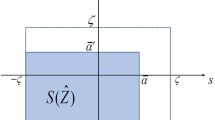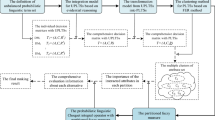Abstract
Probabilistic linguistic Z number (PLZN) is considered as an effective information representation model. It not only describes the decision-making information, but also demonstrates its reliability. To handle the increasing problems of complexity and uncertainty in real-life, PLZN is widely used to indicate qualitative information. In this paper, a novel decision-making method with PLZNs is proposed, focusing on multiple attribute group decision-making (MAGDM) problems with fewer alternatives and more interacted attributes in PLZN environment. Firstly, all basic theories of PLZNs are shown, where the possibility degree of PLZNs is defined. Then, an integration model based on evidential reasoning theory is constructed to aggregate numerous PLZNs, which fully considers the incomplete probability distributions in PLZNs. The mathematical programming model with the generalized Shapley function is introduced to determinate the important degrees of attributes and reflect the interactive characteristics among them. In addition, the probabilistic linguistic Z QUALIFLEX (PLZ-QUALIFLEX) method with the generalized Shapley function is proposed to rank small numbers of alternatives with respect to large numbers of attributes with heterogeneous relationships. Lastly, after demonstrating the rationalities and superiorities of the proposed method, it is applied to solve some numerical cases, in which is compared with other methods.

Similar content being viewed by others
Explore related subjects
Discover the latest articles and news from researchers in related subjects, suggested using machine learning.References
Chen, T.Y.: Interval-valued intuitionistic fuzzy QUALIFLEX method with a likelihood-based comparison approach for multiple criteria decision analysis. Inf. Sci. 261, 149–169 (2014)
Dempster, A.: Upper and lower probabilities induced by a multivalued mapping. Ann. Math. Stat. 38, 325–339 (1967)
Ding, X.F., Zhu, L.X., Lu, M.S., et al.: A novel linguistic Z-number QUALIFLEX method and its application to large group emergency decision making. Sci. Program. 2020, 1631869 (2020)
Feng, X., Liu, Q., Wei, C.: Probabilistic linguistic QUALIFLEX approach with possibility degree comparison. J. Intell. Fuzzy Syst. 36(1), 719–730 (2019)
Grabisch, M.: K-order additive discrete fuzzy measures and their representation. Fuzzy Sets Syst. 92(2), 167–189 (1997)
Huang, J., Xu, D.H., Liu, H.C., et al.: A new model for failure mode and effect analysis integrating linguistic Z-numbers and projection method. IEEE Trans. Fuzzy Syst. (2019). https://doi.org/10.1109/TFUZZ.2019.2955916
Jiang, S., Shi, H., Lin, W., et al.: A large group linguistic Z-DEMATEL approach for identifying key performance indicators in hospital performance management. Appl. Soft Comput. 86, 105900 (2020)
Labella, A., Rodriguez, R.M., Martinez, L.: Computing with comparative linguistic expressions and symbolic translation for decision making: ELICIT information. IEEE Trans. Fuzzy Syst. (2019). https://doi.org/10.1109/TFUZZ.2019.2940424
Meng, F., Tang, J.: Interval-valued intuitionistic fuzzy multiattribute group decision making based on cross entropy measure and Choquet integral. Int. J. Intell. Syst. 28(12), 1172–1195 (2013)
Pang, Q., Wang, H., Xu, Z.S.: Probabilistic linguistic term sets in multi-attribute group decision making. Inf. Sci. 369, 128–143 (2016)
Qiao, D., Shen, K., Wang, J., et al.: Multi-criteria PROMETHEE method based on possibility degree with Z-numbers under uncertain linguistic environment. J. Ambient. Intell. Humaniz. Comput. 11, 2187–2201 (2020)
Ren, Z., Liao, H., Liu, Y.: Generalized Z-numbers with hesitant fuzzy linguistic information and its application to medicine selection for the patients with mild symptoms of the COVID-19. Comput. Ind. Eng. 145, 106517 (2020)
Rodriguez, R.M., Martinez, L., Herrera, F.: Hesitant fuzzy linguistic term sets for decision making. IEEE Trans. Fuzzy Syst. 20(1), 109–119 (2011)
Seiti, H., Hafezalkotob, A., Martínez, L.: R-numbers, a new risk modeling associated with fuzzy numbers and its application to decision making. Inf. Sci. 483, 206–231 (2019)
Shafer, G.: A Mathematical Theory of Evidence. Princeton University Press, Princeton (1976)
Sugeno, M.: Theory of Fuzzy Integral and its Application (Ph.D. Dissertation), Tokyo Institute of Technology, Tokyo, Japan (1974)
Tang, G., Chiclana, F., Lin, X.C., et al.: Interval type-2 fuzzy multi-attribute decision-making approaches for evaluating the service quality of Chinese commercial banks. Knowl. Based Syst. 193 (2020)
Teng, F., Liu, P.: A large group decision-making method based on a generalized Shapley probabilistic linguistic Choquet average operator and the TODIM method. Comput. Ind. Eng. 151, 106971 (2020)
Mahmoodi, A.H., Sadjadi, S.J., Sadi-Nezhad, S., et al.: Linguistic Z-number Bonferroni mean and Linguistic Z-number geometric Bonferroni mean operators: their applications in portfolio selection problems. IEEE Access 8, 98742–98760 (2020)
Wang, J.Q., Cao, Y.X., Zhang, H.Y.: Multi-criteria decision-making method based on distance measure and choquet integral for linguistic Z-numbers. Cogn. Comput. 9(6), 827–842 (2017)
Wang, J., Wu, J., Wang, J., et al.: Interval-valued hesitant fuzzy linguistic sets and their applications in multi-criteria decision-making problems. Inf. Sci. 288, 55–72 (2014)
Wang, X.K., Wang, Y.T., Wang, J.Q., et al.: A TODIM-PROMETHEE II based multi-criteria group decision making method for risk evaluation of water resource carrying capacity under probabilistic linguistic Z-number circumstances. Mathematics 8(7), 1190 (2020)
Wang, X.T., Triantaphyllou, E.: Ranking irregularities when evaluating alternatives by using some ELECTRE methods. Omega 36, 45–63 (2008)
Xu, Z.S.: Uncertain linguistic aggregation operators based approach to multiple attribute group decision making under uncertain linguistic environment. Inf. Sci. 168(1–4), 171–184 (2004)
Yaakob, A.M., Gegov, A.: Interactive TOPSIS based group decision making methodology using Z-numbers. International Journal of Computational Intelligence Systems 9(2), 311–324 (2016)
Yang, J.B., Singh, M.G.: An evidential reasoning approach for multiple-attribute decision making with uncertainty. IEEE Trans. Syst. Man Cybern. 24(1), 1–18 (1994)
Yang, J.B., Xu, D.L.: On the evidential reasoning algorithm for multiple attribute decision analysis under uncertainty. IEEE Transactions on Systems, Man, and Cybernetics-Part A: Systems and Humans 32(3), 289–304 (2002)
Ye, J., Xu, Z., Gou, X.: Virtual linguistic trust degree-based evidential reasoning approach and its application to emergency response assessment of railway station. Inf. Sci. 513, 341–359 (2020)
Zadeh, L.A.: The concept of a linguistic variable and its applications to approximate reasoning-Part I. Inf. Sci. 8, 199–249 (1975)
Zadeh, L.A.: The concept of a linguistic variable and its applications to approximate reasoning pt II. Inf. Sci. 8, 301–357 (1975)
Zadeh, L.A.: The concept of a linguistic variable and its applications to approximate reasoning pt III. Inf. Sci. 9, 43–80 (1975)
Acknowledgements
This work is supported by the National Natural Science Foundation of China (Nos. 71771140, 71471172), the Special Funds of Taishan Scholars Project of Shandong Province (No. ts201511045), the Social Science Planning Project of Shandong Province (No. 20CSDJ23), the Natural Science Foundation of Shandong Province (No. ZR2020QG002).
Author information
Authors and Affiliations
Corresponding author
Rights and permissions
About this article
Cite this article
Teng, F., Wang, L., Rong, L. et al. Probabilistic Linguistic Z Number Decision-Making Method for Multiple Attribute Group Decision-Making Problems with Heterogeneous Relationships and Incomplete Probability Information. Int. J. Fuzzy Syst. 24, 552–573 (2022). https://doi.org/10.1007/s40815-021-01161-3
Received:
Revised:
Accepted:
Published:
Issue Date:
DOI: https://doi.org/10.1007/s40815-021-01161-3




